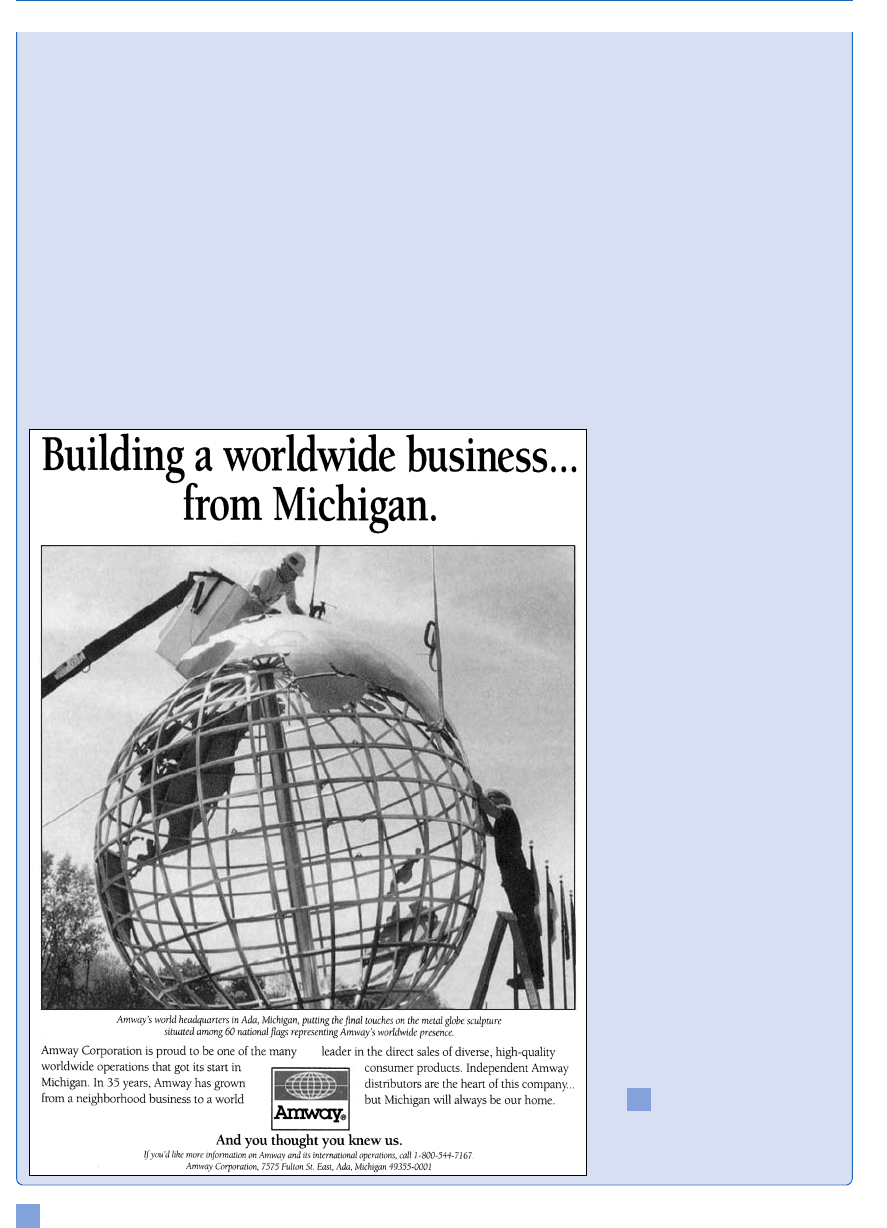Onkvisit S., Shaw J. International Marketing: Analysis and Strategy
Подождите немного. Документ загружается.


also be the exporter, which can ask for full or partial
payment as the project progresses.Thus the seller is
assured of payment for sales made on open account.
The buyer draws by presenting the seller’s draft
with unpaid invoices, and the bank then releases all
or part of the money to the seller.
Back-to-back letter of credit
When the seller is a trading firm or middleman who
must pay a supplier before asking the supplier to
deliver goods to a foreign customer, the middleman
may have to obtain an L/C naming the supplier as
the beneficiary. This can become a problem if the
middleman has inadequate resources to obtain a loan
or an L/C from a bank.What the intermediary can
do is to use the commitment of the customer’s issu-
ing bank (i.e., the customer’s L/C) to collateralize
issuance of the second L/C by the intermediary’s
bank in favor of, say, the supplier.This is an entirely
separate transaction from the original or master
L/C.The intermediary (seller) assigns the proceeds
of the original L/C to its bank, which in turn issues
the bank’s own L/C in favor of the supplier for an
amount not exceeding the original L/C.
Because a back-to-back L/C is a transaction
entirely separate from the original or master L/C,
the bank issuing back-to-back credit is liable for
payment to the supplier even if there is a failure to
complete the requirements of the original credit.
Not surprisingly, many banks are reluctant to be
involved in back-to-back transactions, preferring to
handle the transferable credit option instead.
Transferable letter of credit
Again, when the seller is an agent or broker for the
supplier of the goods, it is difficult for the agent to
have an L/C issued to the supplier if the agent’s
credit standing is weak or unknown. To solve the
problem, the agent or broker may request a trans-
ferable L/C from the buyer.This type of L/C allows
the beneficiary (i.e., agent) to transfer once rights in
part or in full to another party.The agent as the first
beneficiary requests the issuing or advising bank to
transfer the L/C to its supplier (second benefi-
ciary).The transferring bank receives a commission
for doing so.A reduction in the amount, unit price,
shipment period, and validity period are allowed.
Since the agent receives a fee or commission for the
selling effort, the bank will pay the supplier based
on the supplier’s invoices for the transferred (lesser)
amount. The agent then receives the difference
between the full price (the agent’s own invoice) and
the lesser amount (the supplier’s invoice).The trans-
feree (supplier), after making the shipment, submits
documentation to receive payment. After this is
completed, the original beneficiary (agent) obtains
a commission by substituting its invoice with any
other documents evidencing price for the total value
of the sale.The beneficiary presents a draft for the
difference between the supplier’s draft and sales
value covered under the credit.
The dilemma for the agent is that, unlike a back-
to-back L/C, there is a possibility that the transfer-
able L/C may reveal the identity of the supplier to
the agent’s customer and vice versa. Once the buyer
learns of this identity, the buyer may elect to contact
the supplier directly in the future to avoid paying a
commission to the agent.
If the original beneficiary (agent) does not want
the buyer to be identified, the beneficiary’s name or
a neutral forwarder’s name may be substituted for
the buyer’s name.The failure of the agent to provide
the bank with substitute documents immediately
will defeat the whole purpose, since the bank has
the right to deliver the transferee’s documents to
the issuing bank.
Advantages and disadvantages of letters
of credit
The L/C offers several advantages. First, it offers
security while minimizing risk. The bank’s accep-
tance of the payment obligation is a better credit
instrument than a bill of exchange that has been
accepted by the buyer.An L/C creates a better rela-
tionship with the buyer since all terms are specified
and both parties are protected. In addition, the
exporter can receive payment before maturity by
516
TERMS OF SALE AND PAYMENT

discounting the L/C. An L/C can be discounted at
a lower rate because it offers greater security than
a bill of exchange. The discount charge is usually
computed at the current prime bankers’ acceptance
rate from date of purchase to maturity.
For the buyer, the L/C also offers several bene-
fits even though the buyer may have to bear the
burden of financing. First, the buyer can buy now
and pay later. Second, the L/C offers the assurance
of prompt delivery.There is also an expired date for
credit, and no payment is made until the goods are
placed in the possession of a transport carrier for
shipment. In addition, the seller must complete the
terms specified in the L/C before payment is
released.Third, the buyer may receive a better price
since the seller does not have to adopt unnecessary
safeguards or to sell the L/C at deep discount.The
buyer, as a result, may even qualify for the seller’s
cash discount.
It is imperative that the seller carefully examine
the L/C terms to make certain that he or she under-
stands them and can meet the requirements. The
seller must examine such items as the description
of the merchandise, trade terms, price, delivery
date, required documents, the party responsible
for insurance, departure and entry points, and so
on.The seller must also determine whether the L/C
received is confirmed and irrevocable if requested
as such.The seller should not accept an L/C requir-
ing that the inspection certificate be signed by a par-
ticular individual because if that individual, due to
death or other reasons, cannot sign the certificate,
the exporter is unable to fulfill all the require-
ments and cannot collect payment.A precautionary
measure may be to insist that the certificate be
issued by a particular inspection company rather
than a specific person associated with the company.
In spite of the many advantages, the L/C does
have disadvantages as well. The instrument lacks
flexibility, is cumbersome, and is the most complex
method of obtaining payment. Any changes in the
terms require an amendment to the L/C. Although
suitable for a routine transaction, the L/C does not
work well when the transaction is unusual and
requires flexibility. It can also be expensive for the
buyer if the government requires a prior deposit
before establishing the L/C. For example, Lebanon
requires banks to have their customers make a
15 percent deposit on documentary letters of credit
on goods to be sold in Lebanon.
Another reason why the L/C can be a burden to
the buyer is that it entails credit exposure.As such,
the buyer’s credit must be approved in advance by
the buyer’s bank.This is understandable because the
L/C is issued on an unsecured basis, and the buyer-
applicant only pays when the issuing bank is called
on to make payment. Without a satisfactory credit
standing, the bank may require cash or other collat-
eral for its own protection. In fact, a cash deposit
may not even be acceptable if the importer has
financial difficulties or an unknown credit reputa-
tion, since prior creditors may later lay claim to that
amount of money in the event of the importer’s
bankruptcy.As a result, the bank will treat a request
for an L/C as a request for a loan or line of credit.
As such, the practice will tie up a portion of the
buyer’s available line of credit. Furthermore, L/C
fees may range from 1 to 3 percent or perhaps even
higher of the L/C amount.
20
These fees, of course,
add to the importer’s costs.
21
It should be pointed out that an L/C is not a fool-
proof document. Guria, a private company based in
the Republic of Georgia, was persuaded by an
American businessman to relax the terms under
which he could collect on an L/C for his handling
of the purchase of 2900 metric tons of sugar on
behalf of Guria. The businessman then withdrew
$768,500, but the sugar was never delivered. In
another case, National Westminster Bank PLC paid
out $1.8 million on an L/C to an Italian business-
man who forged documents to show the bank that
5000 metric tons of sugar were on the way to a
buyer in Saudi Arabia.The Saudis found out that the
shipment never occurred, and the Czechoslovakian
bank that issued the L/C refused to pay the British
bank.
22
Certainly, the existence of an L/C is not a
substitution for proper business investigation.
The most significant portion of the cost for
an L/C is confirmation. The confirmation cost,
being variable, may range from about 1 percent for
1111
2
3
4
5
6
7
8
9
10111
1
2
3
4
5
6
7
8
9
20111
1
2
3
4
5
6
7
8
9
30
1
2
3
4
5
6
7
8
9
40
41
42
43
44
45111
517
TERMS OF SALE AND PAYMENT

a low-risk country to 6 percent or more for a high
risk country (e.g., Russia).The instrument, because
of its relative greater degree of safety, has a much
lower incidence of losses, reschedulings, or restruc-
turings than the other normal term international
loans. For almost two decades, there appear to have
been no losses on the confirmed letters of credit,
except for the Dominican Republic, Nigeria, and
Iraq – countries that after all failed to meet the
minimum country risk standards at the time.
23
CONCLUSION
The exporter must make an effort to quote a mean-
ingful price by using proper international trade
terms.When there is doubt about how to prepare a
quotation, freight forwarders should be consulted.
These specialists can provide valuable information
with regard to documentation (e.g., invoice, bill of
lading), and the costs relevant to the movement
of goods. Special financial documents such as letters
of credit, however, require a bank’s assistance.
International banks have international departments
that can facilitate payment and advise clients regard-
ing pitfalls in preparing and accepting documents.
Even when an exporting firm is assured of
payment, it still needs to consider the source of
payment and to determine whether it is legitimate.
The company should adopt money-laundering pre-
vention rules. It is important to know one’s client
and exercise due diligence so as to avoid undue
scrutiny from law enforcement agencies.
518
TERMS OF SALE AND PAYMENT
CASE 17.1 COUNTERTRADE: COUNTERPRODUCTIVE?
In modern times barter and its numerous derivations, which have conceptually been gathered together under the
rubric “countertrade,” have gained renewed stature in international trade.This has occurred despite the fact that
international money and credit markets have attained unparalleled levels of sophistication.
Where readily acceptable forms of money exchange and viable credit facilities are available, markets shun cum-
bersome and inefficient barter-type transactions. But, international liquidity problems and government restrictions
on the operation of markets have prompted many less-developed countries (LDCs) and nonmarket economies
(NMEs), as well as industrial countries, to promote “creative” trade transactions that circumvent the normal
exchange medium of modern markets.
The
shortcomings
of countertrade include the following:
1 Countertrade has a high inherent transaction cost.
2 Countertrade limits competitive markets.
3 Countertrade contributes to market distortions that lead to inappropriate economic planning.
Inefficiency in transactions costs
The underlying weakness of countertrade as a mechanism of trade and exchange is its inefficiency. The indivisi-
bility of goods made barter inefficient, for example, and forced those involved with such trade to search for a
better way. Barter gave way to goods/services-for-money exchange, which permitted transactions to incorporate
divisibility as well as time shifting. The opportunity for more convenient (i.e., efficient), multiparty trade became
a reality.
A major factor in the expansion of world trade during the last half of the twentieth century has been the
emergence of a few widely accepted currencies, especially the US dollar, as settlement currencies for international
transactions. The development of international credit markets to support trade depended on the fact that trans-
actions could be entered into without undue concern by the parties involved as to the delivery of the specific

quantity and quality of goods and the timeliness of payment. A key characteristic of this type of market is that
the channels of communication and exchange are well defined and relatively simple.
As a consequence of this clarity and simplicity, such markets are efficient. Specifically, the direct and indirect
costs involved in the process of exchange account for a relatively small portion of the total cost of the transaction.
Such efficiency is not present in the conditional transactions that make up countertrade.The inefficiency cost
must be borne by one or more of the parties involved.
Many countertrade transactions are entered into because the importing country is unable to obtain financing
in the international markets and is short of hard-currency reserves. The lack of access, or limited access, to the
credit markets may be due to restrictions on the country, placed as a condition for specific new lending by the
International Monetary Fund (IMF) or foreign commercial banks. In this environment countertrade is sometimes
viewed by an LDC government as a means of engaging in trade without the cost of entering the international
finance markets.
Whereas it is correct that countertrade may mean that the international financial markets may not have to
be tapped, it is not correct to assume that there are no financing costs associated with a countertrade transac-
tion. In fact, because of the complexity associated with carrying out a countertrade transaction, the cost is higher
than if the LDC has had access to those credit markets. Moreover, countertrade may end up subverting the capital
and austerity restrictions that in some cases are a part of an IMF/LDC lending agreement.
In countertrade the costs of financing are shifted. They become implicit rather than explicit. The seller may
absorb this cost in the form of accepting the obligation to buy or use or resell goods it otherwise would not accept
(thus reducing its return on the transaction). Alternatively, the seller may build the transaction’s finance costs into
the price the buyer must pay. The finance costs are there, though hidden.
Limiting competition
There is another implicit cost when countertrade is required by the LDC or nonmarket economy (NME) buyer as
a condition of the transaction. Countertrade limits the potential number of sellers in the market. Not every seller
firm is willing or able to engage in countertrade; thus, an LDC or NME buyer that insists on countertrade as part
of a trade package limits its potential for obtaining a competitive product, service, or price.The fact is that engag-
ing in countertrade costs the LDC or NME economy more in terms of real resources than a straight commercial
transaction.
Market distortions and false signals
Developing countries may not have well-developed international marketing facilities. As a result they often find it
difficult to break into international markets with goods and services that are nontraditional for their economy.
In other cases an LDC or NME may choose to develop a new domestic industry by buying the technology and
plant from abroad. Domestic demand may not be adequate for an efficient plant size. In response, they may opt
for a larger, more efficient (but possibly from a world supply view, redundant) plant with the expectation of placing
the marginal production on the international market.
Under such conditions counterpurchase or buyback agreements may be sought by the LDC or NME to finance
the importation of plant and equipment for a new industry (as in a buyback agreement) or general imports (as
in a counterpurchase agreement).The LDC or NME also may be seeking a more knowledgeable partner to handle
the international marketing of goods for which it does not have the expertise.
The difficulty with this approach is that countertrade may be used to get goods onto the international market
that would not “make it” under usual conditions and will not be competitive once the buyback agreement expires.
1111
2
3
4
5
6
7
8
9
10111
1
2
3
4
5
6
7
8
9
20111
1
2
3
4
5
6
7
8
9
30
1
2
3
4
5
6
7
8
9
40
41
42
43
44
45111
519
TERMS OF SALE AND PAYMENT

Further, the industrial country firm that accepted the counter-traded goods may dump them, which would be dis-
ruptive to international markets. The result may be that the LDC or NME producer may falsely interpret the
signals and overestimate the real market demand for the dumped goods as being stronger than a longer-term,
unsubsidized, market can bear.
Moreover, the secondary consequences of countertrade transactions are not benign.The inefficiencies of coun-
tertrade – the false-price signals that result in the building of redundant plant and equipment – tend to promote
the establishment of bureaucracies within governments and private firms that have “bought into” countertrade.
In turn, these bureaucracies have a vested interest in maintaining the economic distortions that undergird the
growth in countertrade.
Summing up
Countertrade is a significant factor in modern international trade. In its different forms it is used as a marketing
tool, as a competitive tool, as a tool to restrict trade alternatives, and as a tool to tie the trade of one country
to another country. Countertrade in a modern world economy with highly developed goods, capital, and financial
markets appears on its face to be an incongruous development. Countertrade is a costly, inefficient, and disrup-
tive anomaly. Yet observers of international trade suggest that the volume of countertrade is growing.
Countertrade takes place in a world of imperfection where the political and economic policies of government
and industry distort the relationships between and within the goods, capital, and financial markets.
Points to consider
1 Discuss the pros and cons of countertrade as a form of trade.
2 As a manufacturing firm located in a developed country, you are interested in taking advantage of the Eastern
European markets’ movement toward market-oriented economies. However, your potential customers lack
hard currency and have asked you to consider countertrade. Are you willing to engage in countertrade? Why
or why not?
Source:
Abbreviated and adapted from Jack L. Hervey, “Countertrade – Counterproductive?”
Economic Perspectives
(January/February 1989): 17–24.
QUESTIONS
1 Explain these terms of countertrade: barter, counterpurchase,buyback, offsets, clearing agreement, and switch
trading.
2 Explain these terms of sale: EXW, FAS, FOB, CFR, CIF, DEQ, and DDP.
3 Explain: (a) bill of exchange, and (b) bankers’ acceptance.
4 Explain these types of letter of credit:revocable, irrevocable, confirmed, unconfirmed,back-to-back, and trans-
ferable.
DISCUSSION ASSIGNMENTS AND MINICASES
1 Given that countertrade is a fact of life which is not going to go away, is there any valid argument from a
theoretical
standpoint for this method of doing business?
520
TERMS OF SALE AND PAYMENT

2 Assume that you are a manufacturer being asked to submit a quotation to a potential buyer. How are you
going to prepare your quotation in terms of (a) terms of sale and (b) terms of payment?
NOTES
1 Jack L. Hervey, “Countertrade – Counterproductive?”
Economic Perspectives
(January/February 1989):
17–24.
2 “Russia: What Happens When Markets Fail,”
Business Week
, April 26, 1999, 50–2.
3 Raj Desai and Itzhak Goldberg, “Stakeholders, Governance, and the Russian Enterprise Dilemma,”
Finance
& Development
(June 2000): 14–18.
4 “Noncash Transactions Increase in Russia after Transition to Market Economy,”
IMF Survey
, November 20,
2000, 381–82.
5 “Noncash Transactions.”
6 John A. Angelidis and Nabil A. Ibrahim, “Countertrading with the Middle East: An Empirical Investigation
of Challenges and Opportunities,”
Journal of Global Marketing
8 (No. 2, 1994): 97–114.
7 Bruce Fitzgerald, “Countertrade Reconsidered,”
Finance & Development
(June 1987): 46–9.
8 Ann Ring, “Countertrade Business Opportunities in Russia,”
Business America
, January 11, 1993, 15–16.
9 Sam C. Okoroafo, “An Integration of Countertrade Research and Practice,”
Journal of Global Marketing
6
(No. 4, 1993): 113–27.
10 Sam C. Okoroafo, “A Managerial Approach to Predicting Countertrade Demands by Developing Countries,”
Journal of Global Marketing
6 (No. 1/2, 1992): 171–83.
11 Jean-Francois Hennart, “Some Empirical Dimensions of Countertrade,”
Journal of International Business
Studies
21 (No. 2, 1990): 243–70.
12 Donald J. Lecraw,“The Management of Countertrade: Factors Influencing Success,”
Journal of International
Business Studies
20 (spring 1989): 41–59.
13 Pompiliu Verzariu, “Trends and Developments in International Countertrade,”
Business America
, November
2, 1992, 2–6.
14
A Guide on Countertrade Practices in the Newly Independent States of the Former Soviet Union
(Washington, DC: US Department of Commerce, 1995).
15 “Incoterms 2000,”
Export America
, 11–12. See also the website of the International Chamber of Commerce
for Incoterms 2000. Also see www.look4logistics.com.
16 “Price, Quotations, and Terms of Sale Are Key to Successful Exporting,”
Business America
, October 4, 1993,
12–15.
17 Banks with international departments have publications that explain the various types of collection methods
and documents. For example, see
Trade Banking Services
(BankAmerica Corporation, 1994).
18 “What’s This Credit Worth?”
Collections and Credit Risk
(November 2000): 43ff.
19
Trade Banking Services
,5.
20 D. Grant McKinnon, “Export Sales – the Importance of Setting Competitive Payment Terms,”
Business
America
(February 1995): 6–7.
21 For an in-depth discussion see John F. Dolan,
The Law of Letters of Credit: Commercial and Standby Credits
,
2nd edn (Boston, MA: Warren Gorham Lamont, 1991).
22 “Deals Too Sweet to Be True,”
Business Week
, July 10, 1995, 122.
23 “Export Payment Terms Adjust the Risk to Exporters and the Cost to Importers,”
Business America
, 26–8.
1111
2
3
4
5
6
7
8
9
10111
1
2
3
4
5
6
7
8
9
20111
1
2
3
4
5
6
7
8
9
30
1
2
3
4
5
6
7
8
9
40
41
42
43
44
45111
521
TERMS OF SALE AND PAYMENT

522
Owe your banker a thousand pounds, and you are at his mercy. Owe him a million, and the position
is reversed.
John Maynard Keynes
CHAPTER OUTLINE
■ Nonfinancial institutions
Self-financing and debt financing
Equity financing
■ Financial institutions
■ Government agencies
■ International financial institutions/development banks
World Bank
International Development Association (IDA)
International Finance Corporation (IFC)
Multilateral Investment Guarantee Agency (MIGA)
International Centre for Settlement of Investment Disputes (ICSID)
■ International Monetary Fund (IMF)
Special drawing right (SDR)
Functions
■ Financial centers
Euromarket
Asian Dollar Market
■ Conclusion
■ Case 18.1 Too close for comfort
Sources of financing and
international money markets
Chapter 18

1111
2
3
4
5
6
7
8
9
10111
1
2
3
4
5
6
7
8
9
20111
1
2
3
4
5
6
7
8
9
30
1
2
3
4
5
6
7
8
9
40
41
42
43
44
45111
523
SOURCES OF FINANCING
PURPOSE OF CHAPTER
The examples in the marketing illustration below demonstrate the crucial role that financing plays in secur-
ing overseas projects. Financing is important to the operations of both importers and exporters. Importers
seek financing for the purchase of merchandise. Exporters likewise need financing to manufacture their
products and maintain their inventories. Furthermore, overseas buyers attempt to shift the financing func-
tion to their suppliers. If an exporter agrees to extend credit, the exporter must in turn obtain financing for
this purpose. Financing is not a problem only for small firms. In fact, in the case of international multi-
million-dollar projects, sellers’ financing is usually expected, and financing terms often separate winners
from losers.
Trade finance arises from the export of goods and services, when the buyer and seller negotiate the
amount, time, and terms of payment. The financing needs of the seller and buyer are almost always not
compatible, and sometimes they may even be in conflict. Naturally, the buyer desires a competitive price
and a payment arrangement that does not tie up one’s credit line, whereas the seller wants a financing
arrangement that offers quick payment and protection against default.The method of trade finance attempts
to accommodate these differences. Trade finance can be supplied by parties in the private sector (e.g., the
buyer’s cash in advance payment) or by parties in the public sector (e.g., a bank’s financing of the sale).
The purpose of this chapter is to discuss the various aspects of financing. The chapter covers both the
local and international sources of financing that are available to public and private buyers, including the
various private and nonprofit financial institutions.The chapter also examines such offshore financial centers
as the Euromarket and the Asian Dollar Market.
Any business, no matter how large or small, domestic or international, always requires some kind of
financing for its operations. Because international financing must deal with financial and economic condi-
tions in more than one country, this activity involves more uncertainty and complexity than does domestic
financing. The greater complexity of international financing, however, is accompanied by a greater number
of financing options. In addition to the standard channels, there are also other sources available almost
exclusively for international business. These sources include:
1 Nonfinancial institutions
2 Private financial institutions
3 International agencies
4 The International Monetary Fund (IMF)
5 The Euromarket.
According to the former chairman of the New York
Stock Exchange, “growth in global investing will not
allow markets to be competitive if they constrain
themselves to a time clock.”
Aegon, a Dutch insurer, listed its shares in New
York in 1985. At the time, nobody understood the full
implications of the listing. By allowing its shares to
be traded in the USA, Aegon was able to raise capital.
The stock price fourteen years later made it possible
for Aegon to use its stock as money to buy
Transamerica Corp. The $10.8 billion takeover was
financed mainly with stock. In effect, the company
MARKETING ILLUSTRATION MONEY IS AN EMOTIONAL SUBJECT

524
SOURCES OF FINANCING
became the third largest insurer in the world in terms
of market capitalization.
Likewise, DaimlerChrysler, Vodafone Group PLC,
and a growing number of competitive European com-
panies have used their soaring stock prices to finance
their acquisitions. Daimler was the first of Germany’s
DAX 30 companies to seek a listing in the USA in
1993. The company’s US shares were instrumental
in a $335 billion merger with Chrysler Corp. Had the
US tax laws been comparable to those of Germany,
it might have been Chrysler that acquired Daimler
instead.
Amway Asia Pacific Ltd., a Hong Kong-based
company, is the exclusive distributor for about 175
products of its parent firm, Amway Corp (see Figure
18.1). Amway Asia Pacific distributes the products
in Australia, Hong Kong, Macau, Malaysia, New
Zealand, Taiwan, and Thailand. To raise capital to
finance its operations, Amway Asia Pacific made an
initial public offering in late 1993. Its stock was
valued at $18 a share but actually opened on the New
York Stock Exchange at $26.50. One reason why the
company’s stock is attractive is that it gives investors
an opportunity to profit from the burgeoning market
in China.
Sources:
“A Graveyard Shift for the NYSE?”
Business
Week
, March 8, 1999, 44; “Memo to Europe’s CEOs: Try
Listing on Wall Street,”
Business Week
, March 8, 1999, 54;
“Amway Japan Gears Up for Stock Issue; Analysts Differ on
Company’s Outlook,”
Wall Street Journal
, June 24, 1994.
Figure 18.1 Amway
and world business
Source:
Reprinted with
permission of Amway Corp.

NONFINANCIAL INSTITUTIONS
Self-financing and debt financing
There are several nonfinancial institutions that can
provide financing. First, there is self-financing
because a business can use its own capital or can
withhold dividends so that profits can be plowed back
into the organization for further business expansion.
Second, retailers and manufacturers alike may be
able to seek trade credit and financial assistance from
certain middlemen, such as export merchants and
trading companies. Third, when joint ventures are
formed, foreign partners can also lend a helping hand.
Fourth, subsidiaries of MNCs may borrow from
affiliated firms as well as from the employee retirement
fund.
Finally, the business may decide to raise equity
capital by selling stocks, or it may depend on debt
financing by selling commercial paper or bonds. Bond
buyers or holders are the firm’s creditors rather
than its owners. US firms may sell bonds in either
the USA or foreign countries, with Eurobonds as
a prime example. Treasurers of US firms must
decide whether their bonds to be sold abroad are to
be denominated in the dollar or in foreign curren-
cies. In any case, it should be noted that debt financ-
ing requires the services of investment banks.
Virtually every multinational bank or multinational
brokerage house has a division that acts as an invest-
ment bank.
Another source of financing is venture capital.
Venture capitalists invest funds in a firm in exchange
for a share of ownership. Although known for their
investments in high-technology firms, venture cap-
italists have diversified their portfolios. There are
about 600 venture capital firms in the USA. Private
investors, however, fund most ventures. Venture
Capital Network in Durham, New Hampshire, is a
nonprofit service affiliated with the University of
New Hampshire. Attempting to match entrepre-
neurs with investors, the Network charges investors
$200 a year and those seeking capital $500 annually
for registration.
When self-financing is used, a company should
take advantage of a tax shelter for its export profit.
Because the EU’s exports are exempt from value-
added taxes, the US Congress gave a tax break to
American firms by creating a foreign sales cor-
poration (FSC, pronounced “fisk”). A FSC is a
special kind of corporation, making its possible for it
to gain a corporate tax exemption from 15 to 32 per-
cent of the earnings generated by the sale or lease of
exported goods (i.e., extraterritorial income
derived from goods for sale or use abroad). Some
6000 US companies took advantage of it,resulting in
a $4 billion tax break. In particular, Boeing Co. was
the biggest user of this scheme in 2001, avoiding
$222 million in US taxes or 12 percent of its entire
earnings that year.Acting on the EU’s complaint, the
WTO ruled in 1999 that the FSC program was an
illegal export subsidy that gave American companies
unfair trade advantages.The USA appealed and lost
again.The WTO told the USA to change its law or
risk paying a penalty that could reach $4 billion in
damages. The USA did indeed rewrite its tax law,
creating another tax break that was even more lucra-
tive and that could result in $6 billion of tax break.
The rationale or excuse of the USA was that this
tax shelter prevented US companies from being
taxed twice on income from foreign sources. The
WTO panel, however, ruled that the law was an
illegal export subsidy because the US government
offered a lower tax rate on export profits than
on import and domestic profits. The US Treasury
Department was forgoing income related only to
goods being sent abroad. In addition, the said
income had no link to a foreign state and would
therefore not be taxed anywhere else.The EU com-
plained that the new US legislation made only cos-
metic changes.The WTO later ruled in 2002 against
the USA for the third time, stating that the US tax
provisions were in violation of the WTO’s rules
on subsidies.
1
The EU imposed sanctions in 2004.
Based on a survey of private firms in China,
80 percent feel that their lack of access to finance
is a serious constraint. These Chinese companies
rely heavily on self-financing for both start-up and
expansion. The principal owners, start-up teams,
and their families provide more than 90 percent of
their initial capital. In the case of post-start-up
1111
2
3
4
5
6
7
8
9
10111
1
2
3
4
5
6
7
8
9
20111
1
2
3
4
5
6
7
8
9
30
1
2
3
4
5
6
7
8
9
40
41
42
43
44
45111
525
SOURCES OF FINANCING
